You can create a calming oasis in your garden by choosing anxiety-reducing color palettes. Consider soothing blues and purples, which promote relaxation with lavender and periwinkle hues. A calming green monochrome scheme uses various shades and textures to create tranquility. Soft pinks and whites evoke a sense of calm and purity, while serene lavender and gray combinations offer a stress-free escape. Tranquil earth tones ground your space with rich browns and warm taupes. Gentle yellows and creams create a cozy atmosphere, and cool aqua and mint tones provide a fresh, invigorating feel. Explore these palettes to transform your garden into a peaceful retreat.
Key Takeaways
- Soothing blues and purples, like lavender and periwinkle, create a calming atmosphere with stress-relieving properties.
- Serene lavender and gray combinations offer a tranquil escape, incorporating various lavender types and gray accents.
- Calming green monochromatic schemes use diverse shades and textures to create a lush, anxiety-reducing environment.
- Soft pinks and whites evoke calm and purity, ideal for reducing anxiety when balanced with textural elements.
- Earthy tones, including rich browns and muted greens, promote relaxation and can be enhanced with natural elements.
Soothing Blues and Purples

Three shades dominate the soothing blues and purples palette: lavender, periwinkle, and dusty blue. These calming hues create a serene atmosphere in your garden, helping to reduce anxiety and promote relaxation.
Lavender, with its soft purple tones, is known for its stress-relieving properties and can be incorporated through flowering plants like lavender itself, catmint, or Russian sage.
Periwinkle, a delicate blue-purple shade, adds a touch of whimsy to your garden while maintaining a tranquil feel. Look for plants like forget-me-nots, blue hydrangeas, or clematis to introduce this color.
Dusty blue, a muted, grayish-blue tone, complements the other shades perfectly and can be found in plants such as blue fescue grass or blue hostas.
To maximize the calming effect, arrange these plants in gentle, flowing patterns rather than rigid lines. Intersperse them with white flowers or silver-leaved plants to create contrast and depth.
Don't forget to include seating areas where you can immerse yourself in this soothing color scheme. By surrounding yourself with these cool, calming hues, you'll create a peaceful retreat that helps melt away stress and anxiety.
Calming Green Monochrome

Embrace the tranquility of a green monochrome garden by incorporating varied shades and textures of this nature-inspired hue.
You'll find peace in the subtle differences between lime, forest, and sage greens, creating a harmonious and soothing environment.
Varied Shades, Textures
As you explore deeper into creating a calming green monochrome garden, consider the power of varied shades and textures. While sticking to a single color family, you'll find that incorporating different hues and surface qualities can add depth and interest to your anxiety-reducing oasis.
Start by selecting plants with diverse leaf shapes and sizes. Combine broad, flat leaves with delicate, feathery fronds to create visual contrast. Introduce plants with glossy foliage alongside those with matte or fuzzy textures. This variety will engage your senses and provide a soothing tactile experience.
Don't forget to play with different shades of green. Mix light, chartreuse tones with deep, forest greens to create a rich tapestry of color. Include plants with variegated leaves to add subtle patterns and breaks in the monochrome scheme.
To evoke emotion in your green sanctuary:
- Rustling bamboo leaves whisper tranquility
- Soft moss carpets invite bare feet to explore
- Cascading ferns suggest gentle waterfalls
- Sturdy succulents offer grounding stability
Nature-Inspired Tranquility
Green, nature's dominant hue, holds the power to soothe and restore. By creating a monochromatic green palette in your garden, you'll tap into this calming effect and craft a serene outdoor sanctuary.
Start with a base of soft, muted greens like sage or celadon for your larger plants and ground cover. These gentle tones will set a tranquil foundation for your space.
Layer in medium greens, such as olive or fern, to add depth and interest. Use these shades for shrubs, ornamental grasses, and foliage plants. For pops of brightness, incorporate vibrant lime or chartreuse accents through carefully chosen flowers or statement plants.
Don't forget to include different textures to enhance visual appeal – mix smooth, glossy leaves with fuzzy or feathery foliage.
To maintain a cohesive look, choose planters and garden accessories in neutral tones like white, beige, or gray. These will complement your green palette without competing for attention.
Consider adding a water feature, as the sound of trickling water can further enhance the calming atmosphere. By embracing this nature-inspired green monochrome, you'll create a peaceful retreat that helps melt away anxiety and promotes relaxation.
Soft Pinks and Whites

With their gentle hues, soft pinks and whites create a serene atmosphere in your garden. These delicate colors evoke feelings of calm and purity, making them perfect for reducing anxiety. You'll find that incorporating these shades into your outdoor space can transform it into a peaceful retreat.
Choose plants like pale pink roses, white daisies, and blush-colored peonies to establish this soothing palette. Don't forget to include silvery-white foliage plants like lamb's ear or dusty miller for added texture. You can also introduce these colors through garden accessories like pale pink cushions on white patio furniture or soft pink planters.
To maximize the calming effect of this color scheme, consider these emotional benefits:
- A sense of tranquility and escape from daily stressors
- Feelings of innocence and new beginnings
- Enhanced mental clarity and focus
- A gentle, nurturing environment that promotes relaxation
As you design your garden with soft pinks and whites, remember that balance is key. Too much white can feel stark, while an excess of pink might overwhelm. Aim for a harmonious blend that soothes your senses and creates a welcoming space for relaxation and reflection.
Serene Lavender and Gray
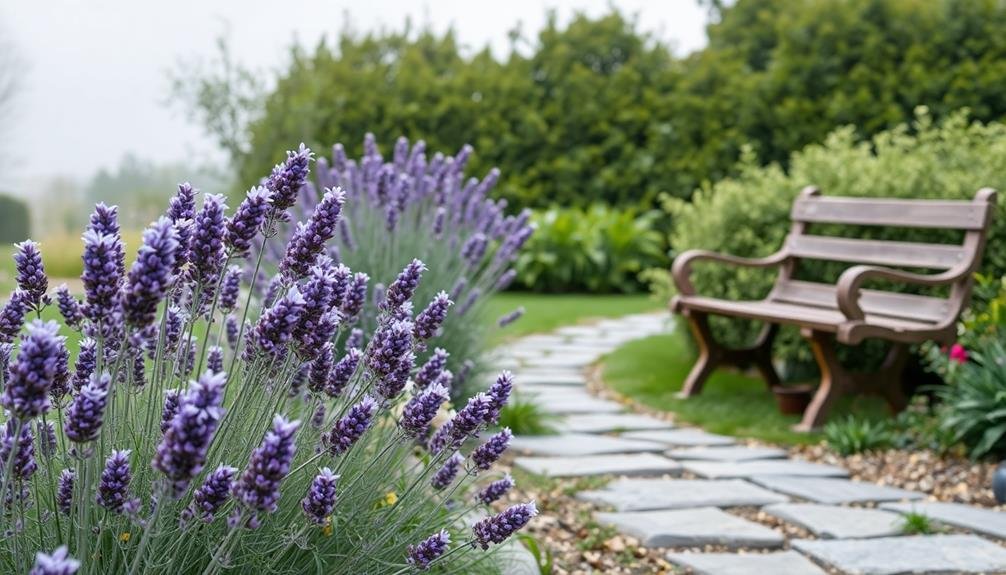
Embrace the tranquility of lavender and gray in your garden to create a serene escape from everyday stress.
You'll find a variety of calming lavender plants, from English lavender to French varieties, that pair beautifully with gray-hued accents like silver foliage or stone elements.
Calming Lavender Plant Varieties
Lavender, with its soothing scent and soft color, is a perfect choice for creating a serene garden atmosphere. You'll find several calming lavender varieties to incorporate into your anxiety-reducing garden palette.
English lavender (Lavandula angustifolia) is a popular choice, known for its compact growth and intense fragrance. It's ideal for borders and containers.
French lavender (Lavandula stoechas) boasts distinctive tufted flowers and thrives in warmer climates. For a unique twist, try Spanish lavender (Lavandula stoechas pedunculata), which features pineapple-shaped blooms with prominent "ears" on top.
When selecting lavender plants, consider their growth habits and care requirements. Some varieties, like 'Hidcote' and 'Munstead,' are more compact and suitable for smaller spaces.
Others, such as 'Grosso' and 'Provence,' grow larger and are perfect for creating lavender hedges or filling larger areas.
- Feel the gentle breeze carrying the calming scent of lavender
- Imagine the soft purple hues swaying in your garden
- Picture yourself relaxing amidst a sea of tranquil blooms
- Envision the peaceful sanctuary you're creating in your outdoor space
Complementary Gray Accents
Gray accents serve as a perfect complement to the soft purple hues of lavender in your anxiety-reducing garden. This neutral color brings balance and serenity to your outdoor space, creating a calming backdrop for the vibrant lavender plants. You'll find that incorporating gray elements can enhance the overall tranquility of your garden.
Consider adding gray stone pathways or gravel to create a sense of structure and flow. These elements not only provide visual interest but also offer a tactile experience as you walk through your garden. Gray planters or containers can house your lavender plants, creating a cohesive look while allowing the purple blooms to stand out.
For vertical interest, install gray trellises or arbors to support climbing plants or create focal points. Weathered wood furniture or benches in shades of gray can provide comfortable seating areas for relaxation and meditation. You might also incorporate gray sculptures or water features to add a touch of elegance and promote a sense of calm.
Don't forget about foliage! Silver-gray plants like dusty miller, lamb's ear, or Russian sage can beautifully complement your lavender, creating a harmonious and soothing color palette throughout your anxiety-reducing garden.
Creating Soothing Color Harmony
The combination of serene lavender and calming gray creates a harmonious color palette that can greatly reduce anxiety in your garden. This pairing offers a soothing visual experience that promotes relaxation and tranquility.
To incorporate this palette, choose lavender-hued flowers like lilacs, wisteria, or catmint, and pair them with gray-leaved plants such as dusty miller or lamb's ear.
Consider using light gray gravel or pebbles for pathways and borders to complement the lavender blooms. You can also add gray planters or garden furniture to enhance the calming effect.
For a subtle touch, paint fences or trellises in a soft gray tone to provide a neutral backdrop for your lavender plants.
To maximize the anxiety-reducing benefits of this color harmony, focus on creating layers and textures within the palette. Mix different shades of lavender and gray to add depth and interest to your garden design.
- Feel the stress melt away as you're enveloped in a sea of soft purples and grays
- Experience a sense of calm washing over you with each gentle breeze
- Find yourself lost in peaceful contemplation among the soothing hues
- Discover a renewed sense of inner peace in your tranquil garden oasis
Tranquil Earth Tones

Nature's calming embrace can be found in tranquil earth tones, offering a grounding effect for your garden oasis.
These soothing hues reflect the natural world, evoking a sense of stability and connection to the environment. Incorporate rich browns, warm taupes, and muted greens to create a serene atmosphere that promotes relaxation and reduces anxiety.
Start by selecting plants with earthy foliage, such as chocolate cosmos, bronze fennel, or copper-colored heucheras.
These plants provide a solid foundation for your tranquil color scheme. Complement them with flowers in soft, muted shades like beige, cream, and pale yellow.
Consider adding ornamental grasses in warm golden hues to add movement and texture to your garden.
Don't forget about hardscaping elements. Choose natural stone pathways, wooden benches, or terracotta pots to reinforce the earthy palette.
You can also incorporate water features with stone or wooden accents to enhance the calming effect.
Gentle Yellows and Creams

Soft and inviting, gentle yellows and creams can infuse your garden with a sense of warmth and tranquility. These soothing hues evoke feelings of sunlight and comfort, creating a serene atmosphere that helps melt away stress.
You'll find that incorporating these colors into your garden design can greatly reduce anxiety and promote a sense of well-being.
When selecting plants for this calming palette, consider options like pale yellow daffodils, creamy white roses, or buttery chrysanthemums. These flowers not only add visual interest but also provide a gentle contrast to the green foliage surrounding them.
You can further enhance the calming effect by including plants with silvery or variegated leaves, which complement the yellow and cream tones beautifully.
To maximize the anxiety-reducing benefits of this color scheme, try to:
- Create a cozy seating area surrounded by cream-colored cushions and soft yellow throw pillows
- Incorporate pale yellow or cream garden ornaments, such as pottery or statues
- Use cream-colored gravel or stepping stones to create winding paths
- Add gentle yellow lighting to extend the calming atmosphere into the evening hours
Cool Aqua and Mint

Moving from warm tones to cooler hues, we explore the calming effects of aqua and mint in your garden. These invigorating colors evoke the serenity of clear waters and crisp mountain air, instantly lowering stress levels and promoting relaxation.
Incorporate aqua through the use of blue hydrangeas, delphinium, or forget-me-nots. These plants not only add a cool splash of color but also create a sense of depth in your garden.
For mint tones, consider planting hostas, lamb's ear, or silver sage. Their soft, pale green foliage provides a soothing backdrop and complements the aqua hues beautifully.
Don't limit yourself to plants alone. Introduce aqua and mint through garden accessories like painted planters, cushions, or a stylish water feature. A pale blue birdbath or a mint-colored garden bench can serve as a focal point while reinforcing the tranquil atmosphere.
To enhance the calming effect, pair these cool tones with white flowers or silvery foliage. This combination creates a fresh, airy feel that's perfect for meditation or unwinding after a long day.
You'll find that spending time in your aqua and mint garden oasis becomes a natural remedy for anxiety and stress.
Frequently Asked Questions
How Do Anxiety-Reducing Color Palettes Affect Mood and Stress Levels?
Anxiety-reducing color palettes can greatly impact your mood and stress levels. They'll calm your mind, lower your heart rate, and promote relaxation. You'll feel more at ease, experience reduced tension, and find it easier to unwind in your surroundings.
Can Color Therapy in Gardens Help With Specific Mental Health Conditions?
Color therapy in gardens can indeed help with specific mental health conditions. You'll find it particularly effective for anxiety, depression, and stress. It's not a cure-all, but it can greatly improve your mood and overall well-being.
Are There Any Colors to Avoid When Creating an Anxiety-Reducing Garden?
You'll want to avoid overly bright or intense colors in your anxiety-reducing garden. Steer clear of vivid reds, oranges, and yellows, as they can be stimulating. Instead, focus on softer, more soothing hues for a calming effect.
How Long Does It Take to Notice the Calming Effects of These Palettes?
You'll likely notice the calming effects of these palettes almost immediately. Your brain processes color quickly, so you can feel more relaxed within minutes of exposure. However, longer-term benefits may develop over days or weeks.
Do Anxiety-Reducing Color Palettes Work Equally Well for Indoor and Outdoor Spaces?
Anxiety-reducing color palettes can work well in both indoor and outdoor spaces. You'll find they're effective in any environment, but outdoor areas may offer additional benefits like natural light and fresh air, enhancing their calming effects.
In Summary
You've now explored seven calming color palettes for your garden. By incorporating these soothing hues, you'll create a tranquil outdoor space that helps melt away stress and anxiety. Remember, it's not just about the colors themselves, but how you combine and balance them. Experiment with different plant varieties, flowers, and garden accessories to achieve your desired effect. Soon, you'll have a peaceful retreat right in your backyard, ready to help you unwind whenever you need it.
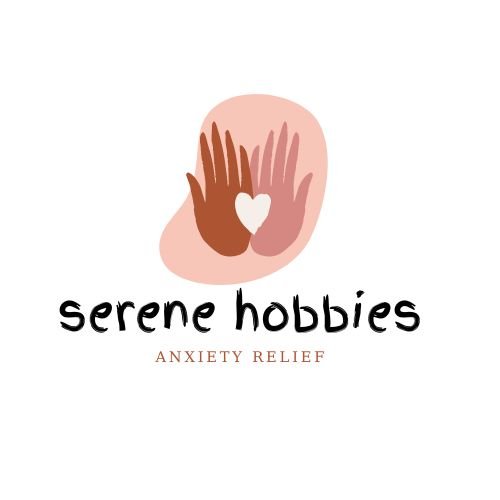
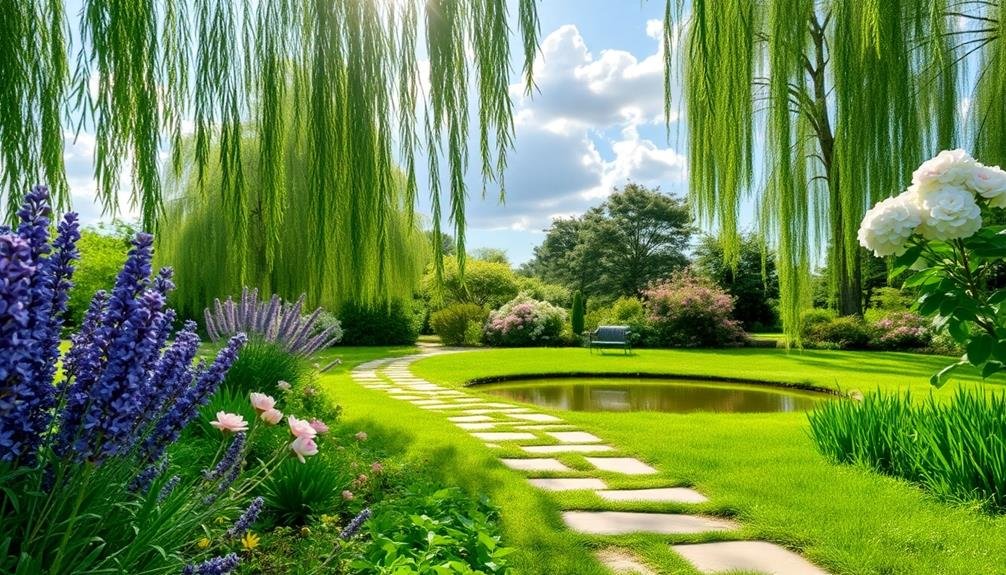

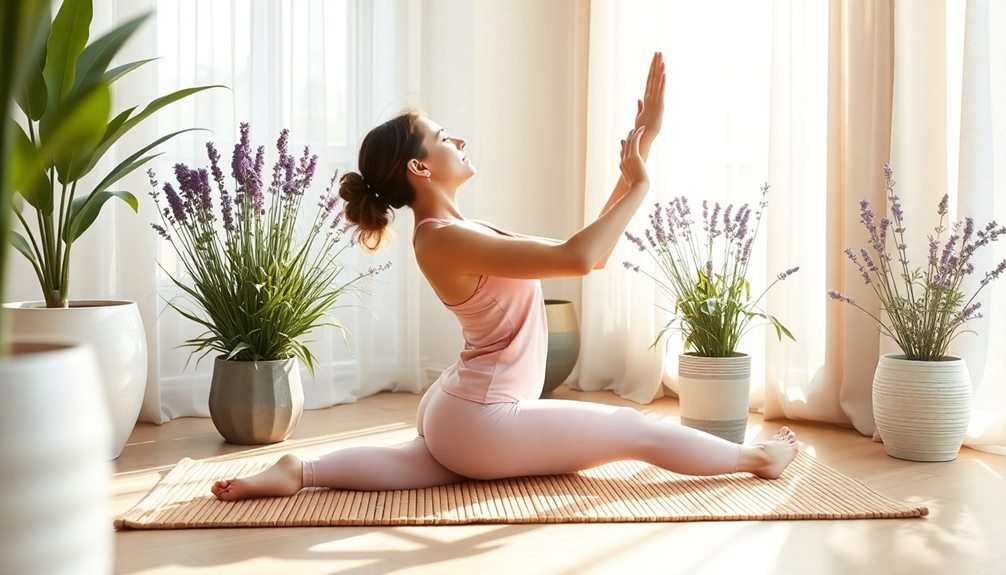
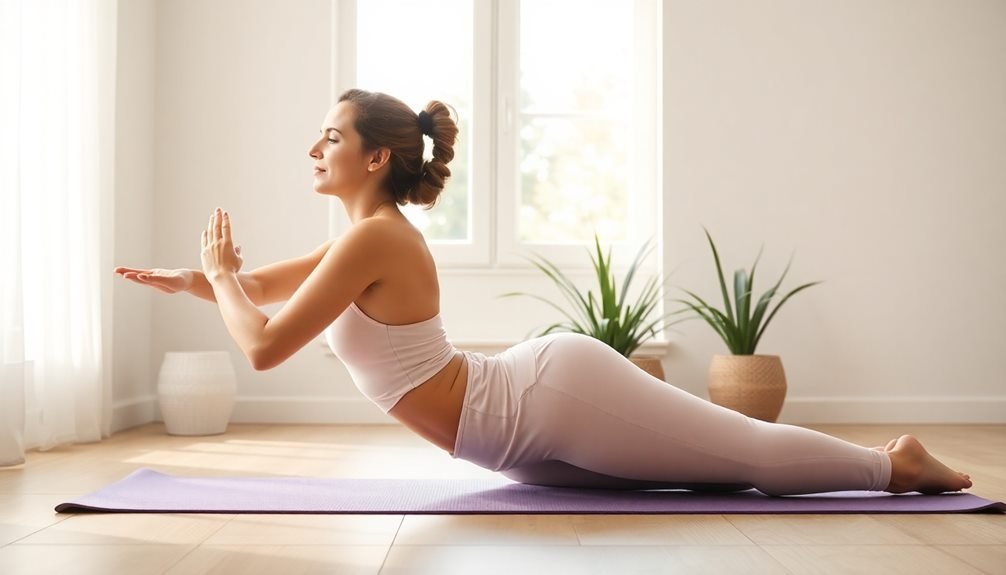
Leave a Reply